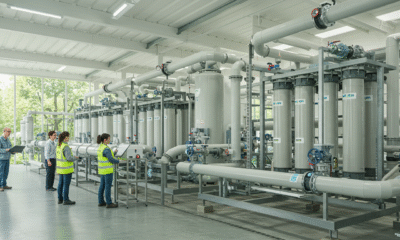

Environment
Green Companies Invest in Tank Monitoring for Spill Prevention
Tank monitoring is important for both municipalities and oil & gas operators, but it seems more complex than it is. Here’s how to do it the easy way.
There are many things that you have to consider when running an eco-friendly company. One of the most important things as a manufacturing is to reduce spills that can harm the surrounding environment.
It isn’t just good business to protect the environment by preventing spills. It is also the law.
What are Spill Prevention Plans?
Did you know that the EPA imposed over $1.06 billion in fines last year for noncompliance with environmental laws? You want to avoid becoming one of them, which means you have to institute a spill prevention plan.
Although it seems fairly self-explanatory, understanding what a Spill Prevention Plan is an important place to start. An SPCC plan outlines the steps that an operator must follow to demonstrate that a company has taken precautions to reduce or eliminate the threat of environmental incidents. You can find details on the importance of these guidelines on the EPA website.
These plans can extend to pretty much any industry, but are common for government contractors, entities or oil & gas providers. Creating these plans is about compliance and preparedness. You also have to follow them to avoid expensive EPA fines. `Operators must have a Spill Prevention Plan in place when they are storing quantities of hazardous fluid.
Spill prevention plan guidelines are put in place to ensure the company has measures in place to reduce the potential for a spill and that they know what to do in the event of a spill.
EPA SPCC Fact Sheet
The Environmental Protection Agency (EPA) provides a fact sheet for Spill Prevention, Control, and Countermeasure (SPCC). The fact sheet helps operators to understand if their specific facility – whether for storage, gathering, or use – is subject to the rules and regulations of the EPA’s protocols.
Interestingly, farms are actually excluded from these protocols, even though they often store large quantities of hazardous chemicals such as oil and diesel.
Most of the agency’s guidelines and concerns surround navigable waters. Above Ground Storage Tanks also have stricter regulations with lower thresholds than any below-ground or buried tanks.
The EPA’s regulations are easily followed by a flow chart of yes and no answers to help operators know what, if any, guidelines they must follow. You can check out more here.
All information is found in the EPA’s 40 CFR 280 or 281.
Using Tank Monitoring For Spill Prevention
Tank monitoring is typically an important part of an SPCC plan, especially monitoring systems that use smart technology. Simply understanding and demonstrating that an operator can measure the tank level, along with having a system in place to stop the pump from running (such as using a SmartPOC – pump-off controller) shows a level of control beyond the current requirement of the law.
A large part of a company’s spill prevention plan is demonstrating that the mechanisms exist within the operator’s system to avoid spills automatically, rather than rely on patient, diligent management to physically maintain the levels of their product.
How Expensive Is Tank Monitoring Equipment?
Many of these systems can be very expensive. Especially SCADA systems, which can run upwards of hundreds of thousands of dollars. However, not all of these systems come at a big price tag.
Reign offers an affordable tank monitoring system that will give you detailed reports for less than a thousand dollars. When the monitoring system is combined with Reign’s SmartPOC for less than $3,000 to acquire (plus a low monthly data transmission cost). Combining these systems goes beyond just monitoring and can actively shut off the pumps that feed the tanks or vessels.
Automating this software provides an extra safeguard to your system. It also assists in making your company and operators compliant with EPA’s SPCC plan regulations and guidelines and also increases the efficiency of your operation. According to customer studies, tank monitoring systems pay for themselves in less than one year, even for marginal wells.


 Environment10 months ago
Environment10 months agoAre Polymer Banknotes: an Eco-Friendly Trend or a Groundswell?

 Environment12 months ago
Environment12 months agoEco-Friendly Home Improvements: Top 7 Upgrades for 2025

 Features9 months ago
Features9 months agoEco-Friendly Cryptocurrencies: Sustainable Investment Choices

 Features10 months ago
Features10 months agoEco-Friendly Crypto Traders Must Find the Right Exchange





























